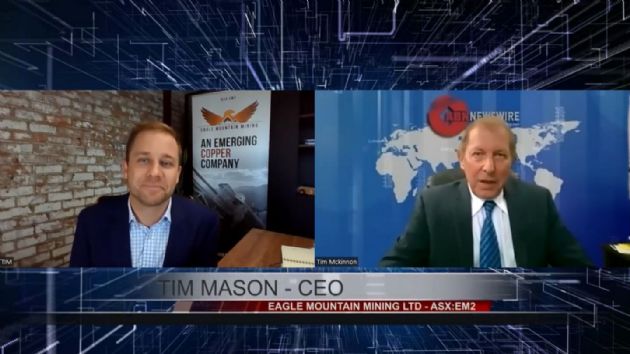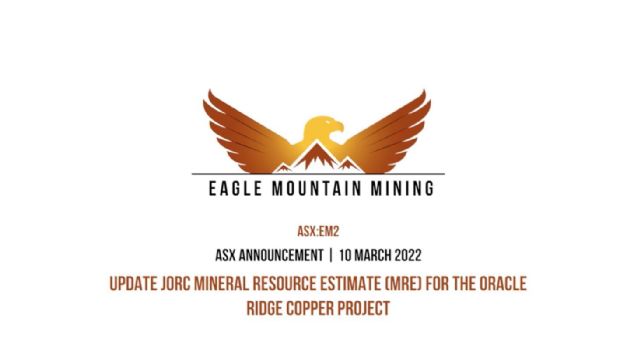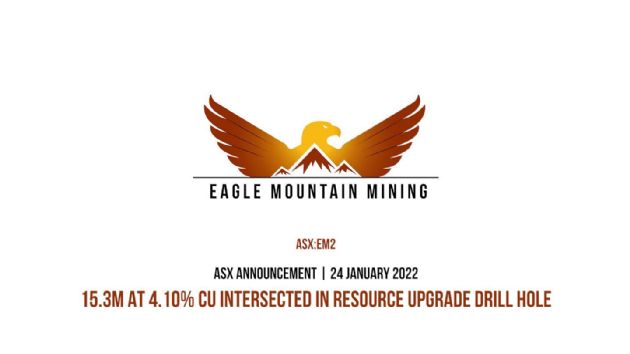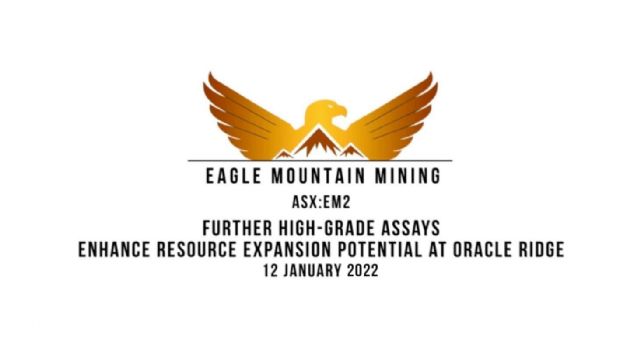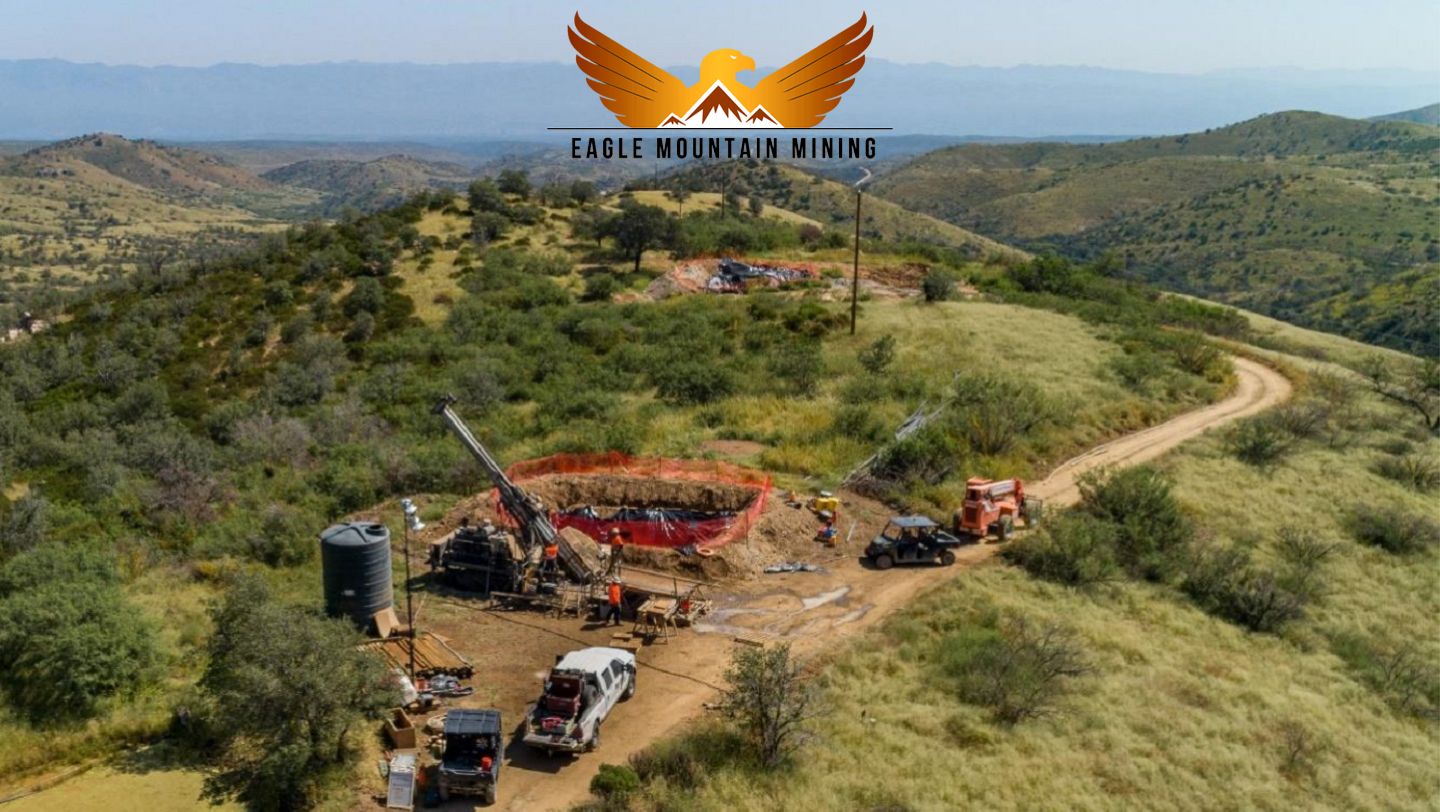
Golden Eagle Drilling Confirms Two Large Mineralised Zones
Perth, Oct 28, 2021 AEST (ABN Newswire) - Eagle Mountain Mining Limited ( ASX:EM2) (
ASX:EM2) ( EGMMF:OTCMKTS) is pleased to provide an exploration update at its 100% owned Oracle Ridge Mine Project ("Oracle Ridge", "Project") in Arizona, USA.
EGMMF:OTCMKTS) is pleased to provide an exploration update at its 100% owned Oracle Ridge Mine Project ("Oracle Ridge", "Project") in Arizona, USA.
- Drilling at Golden Eagle confirms two separate mineralised zones enhancing the prospectivity for large mineralised systems to occur. The two systems are:
o Vein-hosted polymetallic system with alteration extending over 500 metres of strike with localised veining increasing intensity and prospectivity to the west and at depth
o Separate mineralised gold rich system exceeding 650 metres of strike with extensive hematite (iron oxide) alteration with large zones of brecciation open to the west and at depth. Assays include:
- 21.2m at 1.88g/t Au (GE-21-03), including
- 8.0m at 3.80g/t Au, and
- 7.2m at 1.26g/t Au
- Structural interpretation from drilling at Golden Eagle conceptually linked to a separate deeper system which provided the heat source for mineralisation in the area, including the copper skarn mineralisation which hosts the JORC resources at Oracle Ridge
- Multiple geological similarities with other large deposits in the southwest United States and into Mexico, further enhancing prospectivity for additional mineralisation
- 13 holes drilled at Golden Eagle with holes up to 650 metres in length. Assays pending for 11 holes at Golden Eagle. Assays pending for a further 13 holes across Oracle Ridge.
Eagle Mountain Mining CEO, Tim Mason, commented:
"Our maiden drill program at Golden Eagle has uncovered extensive alteration with vein-hosted polymetallic mineralisation. This is exciting because it could represent a distal mineralisation of a larger and deeper porphyry system. The same system could also be driving the copper mineralisation at the Oracle Ridge mine.
While most of our core is still at the laboratory, it is pleasing to see initial visual results confirming vein-hosted polymetallic mineralisation within an extensively altered package. Based on the size and abundance of the veins, we are optimistic about how the mineralisation could evolve laterally with multiple observations suggesting an increase in intensity to the west and at depth. These geological observations share many similarities with other mineralised systems in the southwest United States and into Mexico.
Adding to the polymetallic system, the strong gold assays are a positive indicator of the existence of either separate or associated gold mineralisation.
We have just completed our thirteenth hole at Golden Eagle and have moved that rig back to the mine area to continue resource upgrade drilling. It is prudent that we wait until further assay results are received to enable improved drill planning for the next set of holes. As soon as the new targets are defined, we will be back at Golden Eagle. These results are a major leap forward in our ongoing search for the major system feeding the copper skarn mineralisation at Oracle Ridge."
Highly encouraging results have been received from the Company's maiden diamond drill program at the Golden Eagle Prospect (Golden Eagle). Golden Eagle is located two kilometres to the east of the Oracle Ridge mine portals (Figure 1) and is prospective for different styles of mineralisation other than the skarn-hosted copper-silver-gold deposit at the mine. Thirteen holes have been completed at Golden Eagle targeting the large alteration systems previously identified in the area by surface geological mapping and rock chip sampling (refer ASX announcement 23 August 2021). Based on available historical information, very limited drilling has occurred at Golden Eagle prior to the work completed by Company.
Visual observations showed that most drill holes intersected large widths of altered rocks associated with two separate hydrothermal systems:
- A vein-hosted polymetallic system, characterised by pyrite and silica alteration with localised veins containing lead, zinc and copper sulphides. Intensity of alteration and veining appears to increase to the west and at depth.
- A gold-rich system, confirmed by assay results, displaying abundant hematite (iron oxide) alteration associated with geological structures (e.g. breccias).
Both systems have a strike extent exceeding 500 metres and remain open at depth and to the west (Figure 2*). Assays are awaited for eleven of the thirteen holes drilled. It is expected that assay results will assist in defining exploration vectors towards the most endowed parts of these alteration systems. Importantly, the polymetallic vein alteration could be interpreted as the distal expression of a potential porphyry also linked to the skarn-hosted copper-silver-gold mineralisation at the mine.
Polymetallic vein system
The polymetallic vein system extends from drill hole GE-21-05 to GE-21-12 for a total strike length exceeding 500 metres (Figure 2). From east to west, the system shows a progressive increase in intensity of pyrite dissemination and silica flooding (Figure 3, Figure 6*) with abundance of associated polymetallic (Cu-Pb-Zn) veinlets which also increase westwards. Alteration in places appears spatially associated with the Rice Peak Porphyry intrusive, a Laramide-aged rock. The broader alteration zone straddles a local structure named Pidgeon Tank Fault (Figure 2, Figure 10*), which is interpreted to be a splay of the regionally significant Geesaman Fault. The westernmost drillholes (GE-21-11, GE-21-12) also showed an increase in alteration and veining with depth prompting the completion of an additional hole to test this below GE-21-12. This drill hole (GE-21-13) is currently being logged.
Another alteration feature, which could indicate a higher heat flow and increasing proximity to potentially mineralising fluids and a heat source downhole, is the presence of secondary biotite in vein selvedges. Progressing downward, the biotite veins begin to carry pyrite. Below approximately 315 metres downhole, the biotite-pyrite veinlets contained secondary potassium feldspar selvedges.
Gold system
Previous exploration completed by the Company highlighted a prominent feature crossing the entire Golden Eagle area in a NW-SE orientation, clearly defined by a geophysical magnetic anomaly. This feature was tentatively linked to structural zones or a geological contact and deemed prospective for gold-copper mineralisation based on favourable results from several surface samples (see ASX announcement 23 August 2021).
Several of the drill holes completed to date have intersected a strongly oxidised structural zone associated with brecciated intervals (Figure 5, Figure 8*) over a 650 metre strike length as shown in Figure 2*. Four holes clustered near the intersection of the Geesaman and Pidgeon Tank Faults (GE-21-01 to GE-21-04) showed the most intense oxidation and brecciation. Additional holes broadly spaced to the west intersected thicker zones of moderate oxidation with only minor brecciation. Interestingly the oxidised zones showed an increase in the magnetic response, consistent with the interpretation that this alteration could be generating the magnetic anomaly seen in the geophysical data.
Full assay results have been received for two drill holes (GE-21-01 and GE-21-03) as well as the lower part of GE-21-07 with significant gold values, reported using a 0.5g/t gold cut-off, including:
- 1.6m at 0.91g/t Au and 0.02% Cu from 200.4m (GE-21-01)
- 21.2m at 1.88g/t Au and 0.11% Cu from 236.8m (GE-21-03), including
- 8.0m at 3.80g/t Au and 0.20% Cu, and
- 7.2m at 1.26g/t Au and 0.09% Cu
The assay results received to date for GE-21-07 have returned no significant intersections but the results confirm the correlation between oxidised structures and anomalous gold values.
The presence of a thick zone of gold mineralisation including an eight metre higher grade interval in hole GE-21-03 confirms the gold endowment of this system and indicates the strong potential to host significant gold-copper mineralisation. The mineralised structure remains open at depth (as shown in Figures 4, 5 and 10*) and to the north-west with the magnetic anomaly suggesting potential continuity of this feature for over two kilometres of strike length.
Implications for Porphyry Prospectivity
Porphyry copper deposits are common in Arizona and throughout the southwestern United States including, Twin Buttes, Sierrita-Esperanza, Rosemont, Silver Bell, Mission-Pima, Ajo, Ray, Miami, Pinto Valley, Morenci, Safford, and Resolution. All of these deposits were formed during the Laramide period, a time between 75 and 40 million years ago when the geology was conducive to the emplacement of porphyry copper mineralisation. Besides the time of formation, many of these deposits share a similar structural setting, with fractures and dykes dominated by east-west and northeast-southwest orientations, as well as common host rocks. Moreover, the main porphyry copper is often spatially and genetically associated with other types of mineralisation such as:
- Skarns (including copper, iron, gold, zinc types)
- Polymetallic replacement (silver, lead, zinc, copper, gold)
- Polymetallic veins (gold, silver, copper, lead, zinc, manganese, arsenic)
- Distal disseminated gold-silver (gold, silver)
- Epithermal vein (intermediate/low sulfidation gold-silver)
The Oracle Ridge Project shares many of these geological features common in porphyry copper mines in the southwest United States. These include the presence of intrusive rocks of Laramide Age (e.g. Leatherwood and Rice Peak intrusives), structures with east-west to northeast-southwest orientation (e.g. Geesaman Fault) and favourable host rocks (e.g. Escabrosa, Martin and Abrigo Formations). The Project also contains copper skarns at the Oracle Ridge mine and a recently discovered polymetallic vein system at Golden Eagle. The copper skarns in the mine area also contain varying concentrations of minor molybdenite, which is also common in porphyry systems in the southwest United States.
The current geological model for Oracle Ridge sees the skarn and the polymetallic vein systems as potentially linked to a porphyry system at depth with structures such as the Geesaman Fault and the Pidgeon Tank Fault acting as pathways for the mineralising fluids between the porphyry and sites of metal deposition (Figure 10).
The Company and its consultants will continue to refine this conceptual model with additional information gathered from surface mapping, geophysics and drilling in combination with other advanced exploration techniques (e.g. Portable Infrared Mineral Analyser).
Next steps
Thirteen drill holes have been completed at Golden Eagle with assay results pending for eleven. The Golden Eagle drill rig has recently returned to the Oracle Ridge mine to complete the remaining holes of the Resource Upgrade program.
Assay results, together with additional geological interpretation and possibly a new geophysical survey, will assist vectoring toward more prospective zones at Golden Eagle. New drill holes will be planned once drilling data has been compiled and interpreted.
*To view tables and figures, please visit:
https://abnnewswire.net/lnk/50KW24KV
About Eagle Mountain Mining Limited
 Eagle Mountain Mining Limited (ASX:EM2) (OTCMKTS:EGMMF), is a copper-gold explorer focused on the strategic exploration and development of the Oracle Ridge Copper Mine and the highly prospective greenfield (Silver Mountain) project, both located in Arizona, USA.
Eagle Mountain Mining Limited (ASX:EM2) (OTCMKTS:EGMMF), is a copper-gold explorer focused on the strategic exploration and development of the Oracle Ridge Copper Mine and the highly prospective greenfield (Silver Mountain) project, both located in Arizona, USA.
Arizona is at the heart of America's mining industry and home to some of the world's largest copper discoveries such as Bagdad, Miami and Resolution, one of the largest undeveloped copper deposits in the world.
| ||
|










